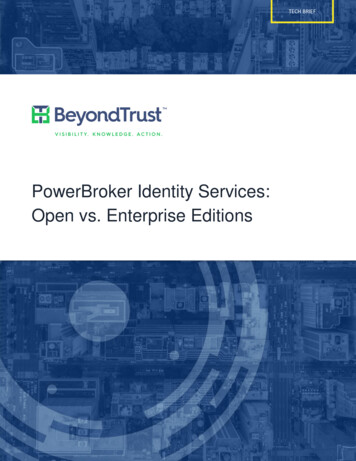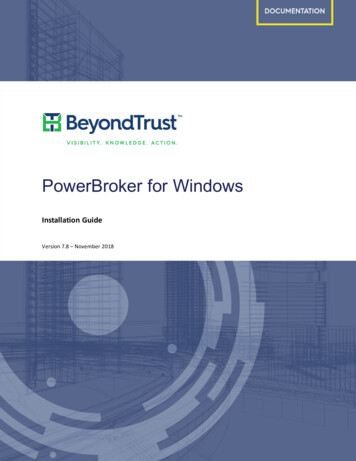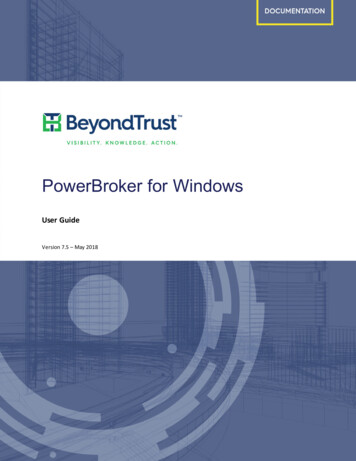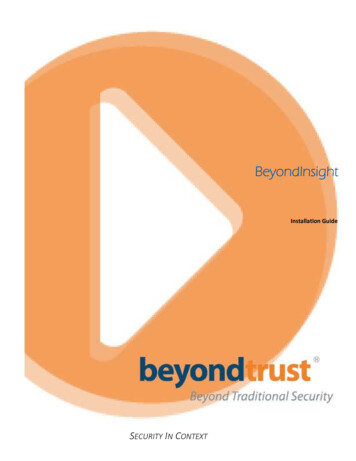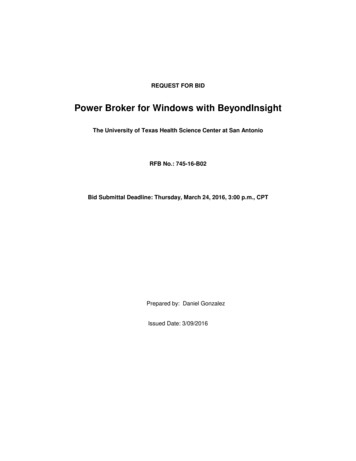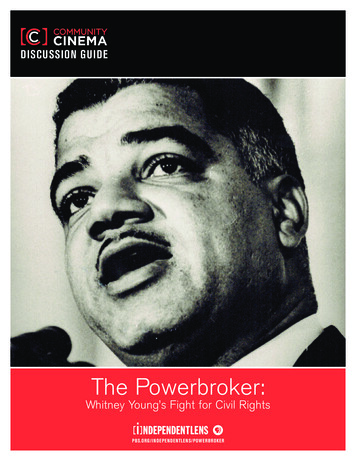
Transcription
DISCUSSION GUIDEThe Powerbroker:Whitney Young’s Fight for Civil Rightspbs.org/independentlens/powerbroker
Table of Contents1Using this Guide2From the Filmmaker3The Film4Background Information5Biographical Information on Whitney Young6The Leaders and Their Organizations8From Nonviolence to Black Power9How Far Have We Come?10 Topics and Issues Relevant toThe Powerbroker:Whitney Young’s Fight for Civil Rights10Thinking More Deeply11Suggestions for Action12Resources13Creditsnational center forMEDIA ENGAGEMENT
Using this GuideCommunity Cinema is a rare public forum: a space for people to gather who areconnected by a love of stories, and a belief in their power to change the world.This discussion guide is designed as a tool to facilitate dialogue, and deepen understandingof the complex issues in the film The Powerbroker: Whitney Young’s Fight for CivilRights. It is also an invitation to not only sit back and enjoy the show — but to step upand take action. This guide is not meant to be a comprehensive primer on a giventopic. Rather, it provides important context, and raises thought provoking questions toencourage viewers to think more deeply. We provide suggestions for areas to explorein panel discussions, in the classroom, in communities, and online. We also providevaluable resources, and connections to organizations on the ground that are fighting tomake a difference.For information about the program, visit www.communitycinema.orgDiscussion guide // THE POWERBROKER1
From the FilmmakerI wanted to make The Powerbroker: Whitney Young’s Fight for Civil Rights because I felt my uncle, WhitneyYoung, was an important figure in American history, whose ideas were relevant to his generation, but whosepivotal role was largely misunderstood and forgotten.In addition, I was raised by my grandparents, Whitney and LauraYoung, so I felt I had a good sense of the important influences onhis life — values that were important and could be shared.My grandparents believed that despite segregation, it was important to never succumb to anger. “Don’t get mad, get smart,” theysaid. “Never let anyone drag you so low as to hate them.” Thesewords of wisdom, I believe, helped Whitney Young become thegreat mediator of the American civil rights movement.By doing this film, as corny as it sounds, I learned to never giveup on my dream. I’m a naturally impatient person, but becausethis was so difficult to accomplish, with so many roadblocks,twists, and turns, I just had to keep going. I think I found a greathome in Independent Lens.Bonnie Boswell HamiltonFilmmakerI hope The Powerbroker: Whitney Young’s Fight for Civil Rightswill inspire young people to cherish their responsibility in helpingto create a more equitable society.People should see this film because it’s a story of triumph overignorance and hate. Generations of African Americans havepassed life lessons on to their descendants, enabling thosedescendants to survive slavery and segregation, turning indignities into sources of courage and determination. I wanted to passthese messages on to young people of all ethnicities who stillconfront a polarized society.Discussion guide // THE POWERBROKER2
The FilmWhitney Young was one of the major leaders of the civil rightsmovement. A man of great intellect and charm, he moved comfortably through the inner sanctums of power, working tirelessly toopen opportunities for African Americans at a time when segregation was still a powerful force in many American institutions. Yet,today he is not as well remembered as other civil rights leaders,despite his many achievements on behalf of African Americans.The Powerbroker: Whitney Young’s Fight for Civil Rights tellsthe story of this great, unsung hero of the civil rights movement, aman who practiced Black Power in a radically different way.Produced by Young’s niece, Bonnie Boswell Hamilton, the film useshome movies, family photos, audiotapes of Young, and neverbefore-seen archival footage to describe Young’s journey fromsegregated rural Kentucky to the segregated U.S. Army, wherehe discovered his talent and skill in interracial mediation. Workingfor the National Urban League in the years following World War II,Young began to gain access to the halls of power and he learnedhow power works. He understood that business leaders were notswayed by moral persuasion, but by being shown the practicalbenefits of a new policy for business. He cultivated relationshipswith people in power and was able to present the case for hiringAfrican Americans to the CEOs of companies such as Ford MotorCompany, Time Inc., and PepsiCo. The more the white worldtrusted Young, however, the more African Americans felt uneasyabout his relationships with corporate leaders. He was labeled asellout, an “oreo,” an “Uncle Tom.” In time, his life was threatened,and as the Black Power movement emerged, authorities arrestedtwo African American men who were plotting to assassinate him.The late 1960s were difficult years for Young. While much of his“Domestic Marshall Plan” found its way into Johnson’s War onPoverty, programs to help the poor were cut because of expenses for the war in Vietnam. Young was caught between the AfricanAmericans he was trying to help and a white world that wasangered and frightened by the militant rhetoric of Black Powerleaders and racial turbulence in the streets of the United States.Although he paved the way for a better life for African Americans,Young’s untimely death in Nigeria in 1971 left a lot of his workunfinished, even to this day.Selected Individuals Featured in The Powerbroker: WhitneyYoung’s Fight for Civil RightsVernon Jordan – Former CEO, National Urban LeagueHenry Louis Gates Jr. – Professor, Harvard UniversityJulian Bond – Founding member, Student NonviolentCoordinating Committee (SNCC)Kenneth Chenault – CEO, American ExpressManning Marable – Professor, Columbia UniversityDennis Dickerson – Whitney Young’s biographerVictor Wolfenstein – Professor, UCLABonnie Boswell Hamilton – Whitney Young’s nieceEleanor Young Love – Whitney Young’s sisterLauren Young Castel – Whitney Young’s daughterAs executive director of the National Urban League during the1960s, Young was part of a group of civil rights leaders who metwith President John F. Kennedy to lobby for civil rights legislationand who planned the 1963 March on Washington. The meetingscontinued under President Lyndon Johnson, whose pragmaticapproach to solving problems was similar to Young’s. The twomen had a close relationship, which became strained as theBlack Power movement took hold. The Vietnam War further complicated the relationship, and also led to a split between Youngand Martin Luther King Jr.Discussion guide // THE POWERBROKER3
Background InformationMilestones in the Civil Rights MovementAlthough most people associate the modern civil rights movement with the 1960s, African American leaders began layingthe groundwork during the previous two decades for the morevisible, more vocal, and ultimately more militant movement thatcame later. In 1941, A. Philip Randolph proposed a march onWashington, D.C. as a way of pressuring the government tointegrate the armed forces and to ensure fair employmentopportunities in defense industries for African Americans. Duringthe 1940s and early 1950s, a series of legal cases resultedin rulings affecting higher education for African Americans.The following is a partial list of the civil rights events that gainedwidespread attention and had far-reaching effects:1948 — President Harry S. Truman issues Executive Order 9981,integrating the armed forces.1954 — In a unanimous decision, the Supreme Court rules inBrown v. Board of Education of Topeka that segregation in publicschools is unconstitutional.1955 — Rosa Parks refuses to give up her bus seat to a whitepassenger, launching the Montgomery Bus Boycott in Alabama,which lasted over a year.1957 — Daisy Bates leads efforts to integrate Little Rock'sCentral High School in Arkansas, amid turbulence, white resistance, and enforcement by National Guard troops.1960 — Four African American students in Greensboro, NorthCarolina, stage a peaceful lunch-counter sit-in, the first of aseries of sit-ins across the South.1961 — “Freedom rides” take place throughout the South to testnew laws prohibiting segregation in interstate travel facilities.1962 — In Birmingham, Alabama, Commissioner of Public SafetyEugene “Bull” Connor uses fire hoses and dogs against civil rightsdemonstrators — images of this are published and televised widely.The March on WashingtonThe March on Washington for Jobs and Freedom tookplace on August 28, 1963, during the centennial year ofthe signing of the Emancipation Proclamation. Initiatedand organized by A. Philip Randolph and his closeassociate, civil rights leader Bayard Rustin, the marchwas much larger than any other previous demonstrationin the nation’s capital, attracting some two hundred andfifty thousand participants. The purposes of the peacefuland orderly demonstration were to call attention to thehigh levels of African American unemployment in theUnited States and to seek a redress of a range of grievances that included the systematic disenfranchisementof African Americans and persistent segregation in theSouth. Marchers were rich and poor, white and AfricanAmerican, the well known as well as ordinary citizens.In addition to the civil rights groups that sponsored theevent, other major organizations lent their weight to theeffort, including the National Council of the Churchesof Christ in the USA, the National Catholic Conferencefor Interracial Justice, the American Jewish Congress,the United Auto Workers, and many other unions. Themarch, televised live to the nation, culminated in a gathering at the Lincoln Memorial with a program of songssung by Marian Anderson, Odetta, Joan Baez, BobDylan, and others, and speeches by the march’s leaders,the most famous being Martin Luther King Jr.’s “I have adream” speech.Sources»» www.core-online.org/History/washington march.htm»» clopedia/enc march on washington for jobs andfreedom1963 — Over two hundred thousand people join the March onWashington (see sidebar).1964 — President Johnson signs the Civil Rights Act of 1964,prohibiting all discrimination based on race, color, religion, ornational origin.1965 — A march in Alabama from Selma to Montgomery in support of voting rights is disrupted by police violence.1965 — Congress passes the Voting Rights Act of 1965, makingrequirements such as literacy tests and poll taxes illegal.Source»» �» crmvet.orgDiscussion guide // THE POWERBROKER4
Biographical Informationon Whitney YoungOne of the major civil rights leaders of the 1960s, Whitney Moore Young Jr. made significant contributionsto the advancement of African Americans, expanding their economic opportunities, particularly in corporateAmerica. His biography in brief follows below:Birth: July 31, 1921, in Lincoln Ridge (Shelby County), KentuckyEducation: Earned a BS from Kentucky State University, ahistorically black institution; Received a Master of Social Work(MSW) degree from the University of Minnesota in 1947Personal: Married Margaret Buchner, January 2, 1944;Two daughtersCareer highlights and accomplishments:1942–1944 — Served in the U.S. Army, achieving the rank ofsergeant; Mediated disputes between African American soldiersand white commanders1950 — Became president of the National Urban League’s Omaha,Nebraska, chapter; Helped expand job opportunities for AfricanAmerican workers; Tripled the chapter’s number of paying members1954 — Appointed dean of the Atlanta University (now ClarkAtlanta University) School of Social Work1960 — Became state president of the Georgia NationalAssociation for the Advancement of Colored People (NAACP);Received a Rockefeller Foundation grant for a year of postgraduatestudy at HarvardDiscussion guide // THE POWERBROKER1961–1971 — Served as executive director of the National UrbanLeague; Increased the number of employees from 38 to 1,600and the budget from 325,000 to 6.1 million; Expanded themission to include programs such as “Street Academy” for highschool dropouts and “New Thrust” to support local AfricanAmerican community leaders1969–1971 — Served as the first African American president ofthe National Association of Social Workers (NASW)1960s — Proposed a “Domestic Marshall Plan” focused on citiesand described in his book To Be Equal (1964), calling for 145billion over 10 years to eradicate ghettos and improve education,health services, and housing; His proposals were partially incorporated into President Johnson’s War on PovertyThroughout his career — Cultivated relationships with high-levelwhite business and political leaders in order to improve theopportunities available to African AmericansDeath: Drowned while swimming in Lagos, Nigeria, March 11, 1971Sources:»» oungBiography.htm»» www.defense.gov/news/newsarticle.aspx?id 439885
The Leaders and Their OrganizationsSometimes referred to as the “Big Six,” the civil rights leaders who appear in The Powerbroker: WhitneyYoung’s Fight for Civil Rights were the most prominent spokesmen for the movement in the 1960s. Inthe preceding decades, these leaders and their organizations had often worked together to advance thecauses of African Americans. Despite tensions and disagreements between them during the 1960s, theyprovided a unified front in seeking full rights for African Americans, and until the second half of the decade,all adhered to Gandhian principles of nonviolent action.(Note: The positions listed are those held during the 1960s.)James L. Farmer Jr. (1920-1999), co-founder and first nationaldirector of the Congress of Racial Equality (CORE), was born inMarshall, Texas. He graduated from Wiley College in 1938 andreceived a divinity degree from Howard University in 1941.CORE was founded in 1942 by an interracial group of students asa pacifist organization that sought to change racist attitudes. Thefounders were influenced by Gandhi’s teachings about nonviolence,and CORE brought tactics such as sit-ins and “freedom rides” tothe civil rights movement. By the late 1960s, the membership hadbegun advocating for a more aggressive approach, and whenFarmer stepped down, he was replaced by more militant leadership.Source:»» www.core-online.org/History/james farmer.htmMartin Luther King Jr. (1929-1968), president of the SouthernChristian Leadership Conference (SCLC), was born in Atlanta,Georgia. He received a BA from Morehouse College in 1948, adivinity degree from Crozer Theological Seminary in Pennsylvaniain 1951, and a PhD from Boston University in 1955. In 1964 hewas awarded the Nobel Peace Prize.The SCLC grew out of the Montgomery Bus Boycott that tookplace from December 1955 to December 1956 under King’sleadership. Founded in 1957, the SCLC adopted nonviolentmass action as its main strategy and made the SCLC open to all,regardless of race, religion, or background.Source:»» www.nobelprize.org/nobel prizes/peace/laureates/1964/king-bio.htmlJohn Lewis (1940- ), chairman of the Student NonviolentCoordinating Committee (SNCC), was born to sharecropperparents in Troy, Alabama. He was educated in Nashville, where hegraduated from the American Baptist Theological Seminary andreceived a bachelor's degree in Religion and Philosophy from FiskUniversity. Since 1987 he has served as U.S. Representative forGeorgia’s Fifth Congressional District.SNCC was founded in April 1960 by young people who had ledthe lunch-counter sit-ins in Greensboro, North Carolina, earlierthat year. Based on a philosophy of nonviolence, SNCC becamea force in the 1961 Freedom Rides and voter registration efforts.In 1965, some members began to challenge the group’s commitment to nonviolence, leading to a divisiveness that weakened theorganization. As SNCC’s militancy increased, it became a targetof the FBI’s Counterintelligence Program. Many of SNCC’s mostdedicated members left the group, and by the late 1960s theorganization had disintegrated.Source:»» clopedia/enc studentnonviolent coordinating committee snccAsa Philip Randolph (1889-1979), organizer and president ofthe Brotherhood of Sleeping Car Porters (BSCP), was born inCrescent City, Florida. He was educated at Cookman Institute, anacademic high school for African Americans. He abandoned theatrical ambitions to study economics at City College of New York.BSCP represented the first serious effort to form a labor organization within the Pullman Company, a major employer of AfricanAmericans. While the organization itself did not play as prominent a role in the civil rights struggle as the others listed here,Randolph was an activist throughout his adult life, both as a labororganizer and a civil rights leader. Along with Roy Wilkins of theNAACP and Arnold Aronson of the National Jewish CommunityRelations Advisory Council (now the Jewish Council for PublicAffairs), Randolph founded the Leadership Conference on CivilRights, which has coordinated the legislative campaigns of everymajor civil rights law since 1957.Source:»» scussion guide // THE POWERBROKER6
Roy Wilkins (1901-1981), executive director of the NAACP, wasborn in St. Louis, Missouri. He received a degree in sociologyfrom the University of Minnesota in 1923.The NAACP was founded in 1909 by a group of white descendants of abolitionists and several prominent African Americans,among them W.E.B. DuBois, Ida B. Wells, and Mary ChurchTerrell. The organization has focused on removing barriers toracial equality through legislative and judicial processes. Throughits Legal Defense and Educational Fund, headed by ThurgoodMarshall, the NAACP scored many victories on behalf of economic and social justice for African Americans, including the1954 Brown v. Board of Education desegregation case.Source:»» ssion guide // THE POWERBROKERWhitney Young (1921-1971), executive director of the NationalUrban League, was born in Lincoln Ridge, Kentucky.The National Urban League grew out of the Freedom Movement,better known as the Great Migration, when large numbers ofAfrican Americans left the South and moved to northern cities.In the early 1900s, several organizations were established tohelp the migrants, who were inexperienced in city living, adjustto urban life and reduce the discrimination they faced. In 1911these groups merged to form the National League on UrbanConditions Among Negroes, later renamed the National UrbanLeague. Interracial in character, the League has waged a multifaceted campaign since its founding to bring educational andemployment opportunities to African Americans.Source:»» nul.iamempowered.com7
From Nonviolence to Black PowerThe American civil rights movement is considered one of themost successful uses of nonviolent protest to achieve specificgoals. All the major civil rights organizations and their leadersadhered to precepts taught by Mahatma Gandhi, especially theprinciple of satyagraha, which is central to Gandhi’s philosophyof nonviolence. Satyagraha can be loosely translated as “truthforce,” and stands in contrast to both passive resistance andarmed struggle. It is a weapon of the strong, and it is activelyand deliberately employed, never allowing the use of violence.As a strategy for change, nonviolence involves the active withdrawal of citizens’ consent and cooperation from an incumbentregime or current system. The arsenal of “weapons” availablefor nonviolent action is wide-ranging and includes those tacticsmost frequently used in the civil rights campaign, such as sit-ins,boycotts, and marches.By 1966, some within the movement were becoming impatientwith the nonviolent approach practiced by the SCLC, the NAACP,and others in the mainstream civil rights movement. The youngermembership of SNCC wanted more concessions for AfricanAmericans more quickly and they adopted more radical, militantlanguage and tactics. They criticized the moderate path the elderleaders were following and rejected desegregation as a goal,calling instead for a more defined, separate position of powerfor African Americans. The idea behind the Black Power movement was to unite African Americans into a political force, withan emphasis on African American self-sufficiency. Although theContributions of the Black Power MovementCriticized by civil rights leaders for turning toward harshrhetoric and more aggressive tactics, the Black Power movement nevertheless succeeded in energizing African Americansto realize their potential for personal and professional growth.While some argue that Black Power led to the isolation of theAfrican American community by rejecting assimilation into themainstream culture, the movement is also credited with uplifting African Americans by cultivating feelings of racial solidarity.Other ways that the movement increased Black Power werethat it helped organize self-help groups and community organizationsnot dependent on whites to succeed; put greater emphasis on African American history and culture; encouraged the establishment of African American Studiesprograms;Discussion guide // THE POWERBROKERBlack Power movement was criticized by mainstream civil rightsleaders and became a target of FBI investigations, the movement ultimately resulted in a number of positive developments(see sidebar).Some of the major figures of the Black Power movement were Stokely Carmichael (1941-1998) — A civil rights activist whoparticipated in the 1961 Freedom Rides; Became chairman ofSNCC — after John Lewis — in 1966, and began speaking aboutBlack Power Bobby Seale (1936- ) — An activist who co-founded (withHuey Newton) the Black Panther Party for Self-Defense afterthe assassination of Malcolm X in 1965; One of the “ChicagoEight,” charged with conspiracy and inciting to riot during theDemocratic National Convention in Chicago in 1968 H. Rap Brown (1943- ) — Served as SNCC chairman followingStokely Carmichael, during a period of alliance between SNCCand the Black Panthers; Currently serving a life sentence for themurder of a Fulton County (Georgia) sheriff in 2000 Louis Farrakhan (1933- ) — Leader of the Nation of Islam (NOI),he was second in command during the 1960s; The NOI’s statedgoal is the improvement of the spiritual, social, and economicconditions of African Americans; In October 1995, he organizedand led the Million Man March in Washington, D.C.Source:»» blackhistory.com/cgi-bin/blog.cgi?blog id 62378&cid 54 mobilized African American voters to elect African Americancandidates; led to the “Black is Beautiful” movement, helping AfricanAmericans feel pride in themselves and their appearance; gave rise to the Black Arts Movement, founded in Harlem bywriter and activist Amiri Baraka (LeRoi Jones), encouragingAfrican Americans to establish publishing houses, magazines,and art institutions.Effects of the movement rippled beyond the African Americancommunity, as other groups — Latinos, Native Americans, AsianAmericans — took inspiration from Black Power to deal with theirown issues of identity politics and cultural expression.Source:»» blackhistory.com/cgi-bin/blog.cgi?blog id 62378&cid 548
How Far Have We Come?There is no question that the civil rights movement produced major changes for African Americans andtore down barriers of discrimination in education, housing, the workplace, and the voting booth. After theelection of Barack Obama as President of the United States in 2008, there was much talk of the UnitedStates now being a postracial society, one where race no longer mattered. But subsequent events havecast doubt on this feeling, and two recent polls indicate that America has not yet reached a point of trueracial equality.Looking at racial progress since the civil rights era, a 2011 USAToday/Gallup poll found that about 90 percent of both blacks andwhites say that civil rights for African Americans have improved.But in other areas, there is not so much agreement. Here aresome of the poll’s findings: Blacks have as good a chance as whites to get any job for whichthey are qualified — 78 percent of whites (41 percent in 1963);39 percent of blacks (23 percent in 1963) agree New civil rights laws to reduce discrimination are needed —15 percent of whites, 52 percent of blacks agree Approve of interracial marriage — 83 percent of whites(17 percent in 1968); 96 percent of blacks (56 percent in 1968) Relations between blacks and whites “will eventually be workedout” (black responses only) — In 1963: 70 percent agree, 26percent disagree, “would always be a problem”; In 2011: 55percent disagree, “conflict won’t end”A 2012 Associated Press poll of racial attitudes found thatracial prejudice has increased slightly in the four-year period of2008 to 2012 from 48 percent to 51 percent, while the percentexpressing pro-black attitudes has decreased.Thus, while electing an African American president represented asea change in American politics and racial attitudes, much morework needs to be done before the United States can call itself“postracial.”Sources:»» ity-poll-mlk n.htm»» e-poll-inside n.htm»» prejudice-againstblacks Obama’s presidency will improve race relations in theUnited States (all Americans) — 70 percent (2008), 35 percent(2011) agreeDiscussion guide // THE POWERBROKER9
Topics and Issues Relevantto The Powerbroker:Whitney Young’s Fight forCivil RightsA screening of The Powerbroker: Whitney Young’s Fightfor Civil Rights can be used to spark interest in any of thefollowing topics and inspire both individual and communityaction. In planning a screening, consider finding speakers,panelists, or discussion leaders who have expertise in oneor more of the following areas:Nonviolent protestThinking More Deeply1.After seeing the film, why do you think Young is not as wellremembered as some of the other figures in civil rights history?2.What do you think about Young's arguments for integration'sbenefits for business? What is the relevance of these points intoday's world?3.Why do you think African Americans felt uneasy about Young’scloseness to the white business and political establishment?4.What do you think about Whitney Young Sr.’s “secret curriculum”at the Lincoln Institute? Was it necessary for him to be deceptiveabout what the students were learning? If so, why?5.In the film, Henry Louis Gates Jr. says that the media was responsible for the success of the civil rights movement. The media hasalso been given credit for helping to end the Vietnam War. Doyou agree that the media can have this much influence? Why orwhy not? What role is the media playing in current social andpolitical movements?6.The media was also criticized for sensationalizing the BlackPower movement and stoking fear among white Americans. Inyour opinion, was this criticism justified? Can you think of currentexamples of the media overemphasizing a local or national storyand arousing strong emotions in the public?7.Compare the effectiveness of the Black Power movement tothe slower, more deliberate approach of the mainstream civilrights organizations. Did they each advance the cause of AfricanAmerican civil rights? If so, how?8.Victor Wolfenstein of UCLA suggests in the film that white peoplefear African Americans. Do you agree? If so, what is the basis ofthis fear?9.Both Young’s “Domestic Marshall Plan” and President Johnson’sWar on Poverty placed special emphasis on preferential treatmentof African Americans in order to compensate for the damage thathad been done to them economically, socially, and educationally.In recent years, there have been calls to end various types ofaffirmative action. Do you think that affirmative action should havetime limits? If so, how would you define those limits? If not, whatis the justification for extending affirmative action indefinitely?Segregation/integrationRace relations in the United StatesCivil rightsRace and politicsAfrican American leadersInterracial harmonyWar and raceThe Black Power movement10. What effect has the presidency of Barack Obama had on racialattitudes and race relations in the United States?Discussion guide // THE POWERBROKER10
Suggestions for ActionTogether with other audience members, brainstorm actions that you might take as an individual and thatpeople might do as a group. Here are some ideas to get you started:1. Work with other interested individuals to organize an interracial 5. Keep abreast of the NAACP’s Action Alerts and take action onthose issues that are especially important to you. Find out aboutdialogue in your community. To help with this activity, you mightother ways to get involved in the NAACP by contacting the localconsult the One America Dialogue Guide from President Billchapter. Get details at www.naacp.org.Clinton’s Initiative on Race, which offers comprehensive guidelines for conducting a discussion about race. Find the guide6. The Southern Christian Leadership Conference (SCLC) welcomesat e participation of volunteers in its mission to promote economicAlternatively, your place of worship or a local college or universityjustice and civil rights. Find a chapter in your area at atm.net/may already have a similar initiative in place and can provide .pdf andsupport needed for your effort.learn how you can be involved.2. In advance of the next election in your area, help to increase7. The National Urban League offers numerous volunteervoter registration, especially among minority groups, youngopportunities for those interested in supporting its n
The Powerbroker: Whitney Young's Fight for Civil Rights tells the story of this great, unsung hero of the civil rights movement, a man who practiced Black Power in a radically different way. Produced by Young's niece, Bonnie Boswell Hamilton, the film uses home movies, family photos, audiotapes of Young, and never-



